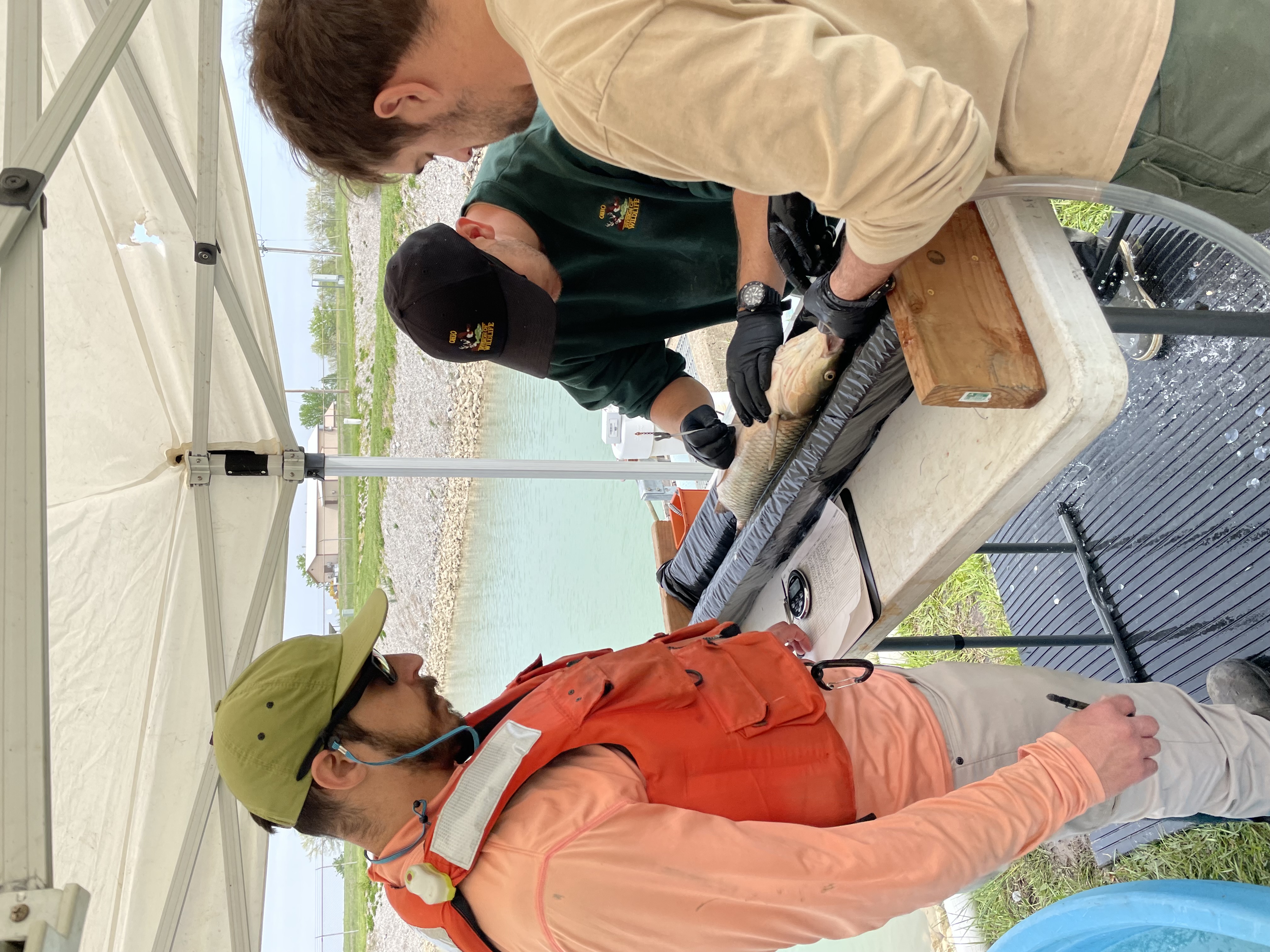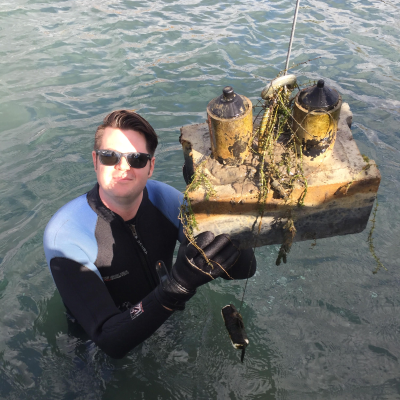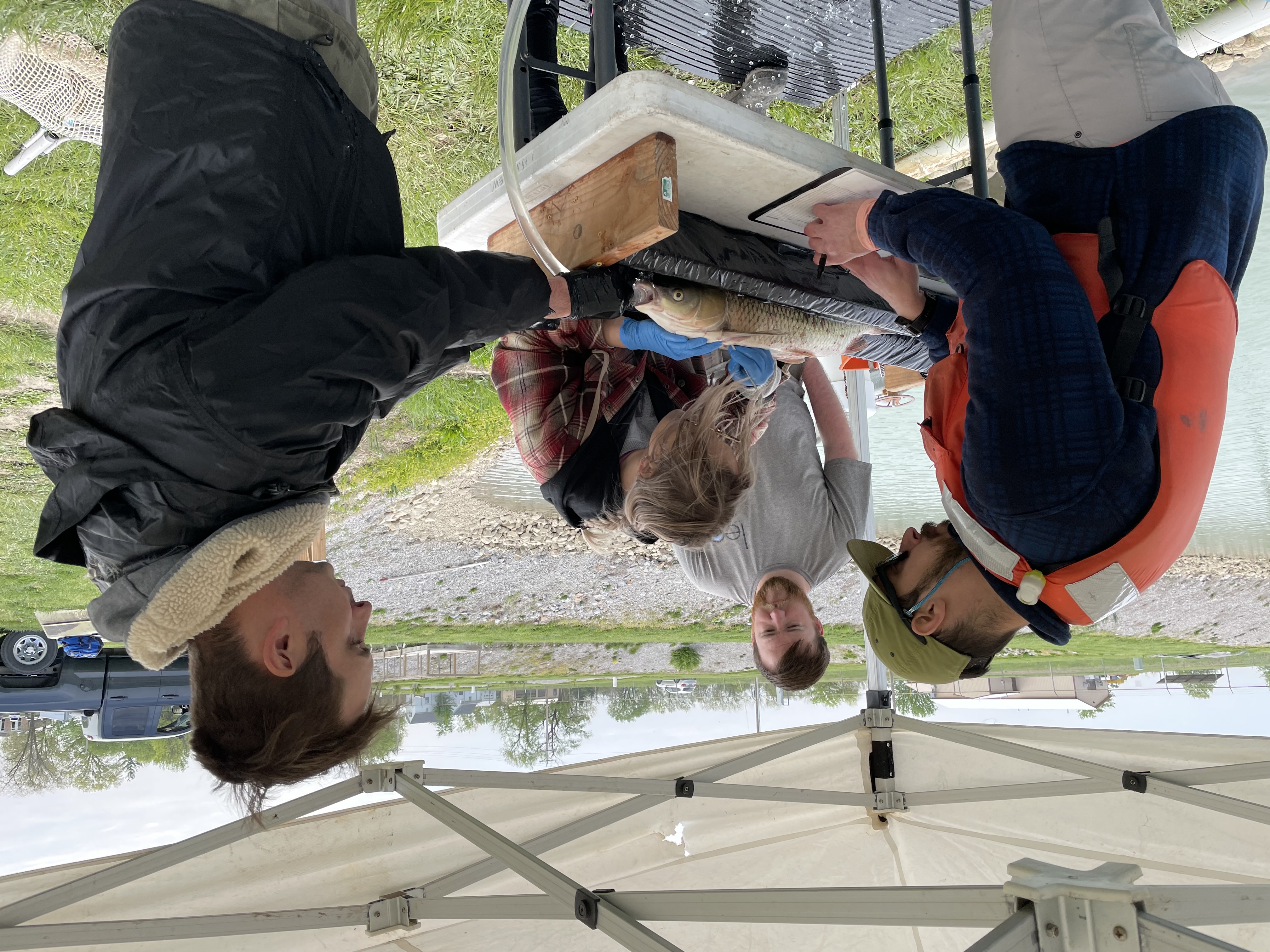MSU-led research helps safeguard the Great Lakes from invasive grass carp through science-driven management
MSU scientists are using cutting-edge tracking technology and multi-agency collaboration to reduce grass carp threats to Great Lakes ecosystems.
Key Points:
- Invasive grass carp pose a serious ecological and economic threat to the Great Lakes, capable of disrupting fisheries, habitats and regional economies.
- MSU research is providing the science-based information agencies need to detect, capture and limit the spread of this destructive species.
- Proactive, research-informed management strategies reduce long-term control costs and safeguard the environmental and economic integrity of Michigan’s water resources.
EAST LANSING, Mich. — Research from Michigan State University is protecting the Great Lakes from a dangerous threat looming specifically in and around Lake Erie.
For roughly a decade, MSU scientists have been studying grass carp, one of four carp species invasive to U.S. freshwater ecosystems (bighead carp, silver carp and black carp are the other three).
All four species share similarities that can dramatically disrupt the ecological communities they find themselves in, such as the size they can grow to by being lavish feeders (upward of four feet long and 100 pounds) and the prolific rate at which they can reproduce — amplified by the fact that there are no natural predators in the Great Lakes to neutralize their presence.

Whereas silver carp and bighead carp feed on plankton and can compete with the juvenile life stages of important Great Lakes species such as walleye, yellow perch and lake whitefish, grass carp feed on aquatic vegetation and can disrupt riverbanks and lakefronts, affecting fish, bird and wildlife populations and promoting increased algal blooms and decreased water clarity.
While recent attention has been given to preventing bighead and silver carp from migrating into Lake Michigan by implementing deterrent measures as they move northward through the Mississippi River basin, grass carp have been detected in the Great Lakes basin since the 1980s. Presently, grass carp have been detected in each of the Great Lakes except for Lake Superior, with the greatest number of detections coming from Lake Erie.
In 2015, urgency to control grass carp increased considerably when natural spawning was documented as occurring in Lake Erie’s watershed.
According to MSU Fisheries and Wildlife assistant professor Scott Colborne, the carp aren’t breeding in the Great Lakes themselves, but rather nearby tributaries. That’s where he and team members from MSU’s Quantitative Fisheries Center — which is supported, in part, by MSU AgBioResearch — have stepped in to study the intricacies of their behavior in these river systems and use what’s learned to better catch and contain them.
“Our best indicators show that the population of grass carp is still relatively low in and around the Great Lakes, which gives us a chance of maintaining this status and — if we’re really fortunate — extirpating and eliminating future reproduction events,” Colborne said. “Our ultimate goal is that grass carp are no longer established in the Great Lakes, and we still have a chance at making that happen.”

Colborne is taking over for Travis Brenden, a professor in the MSU Department of Fisheries and Wildlife and director of the Quantitative Fisheries Center, as principal investigator of the project. While the initial research related to grass carp was spearheaded and funded by the Michigan Department of Natural Resources (DNR) Fisheries Division, the U.S. Geological Survey (USGS) has become the primary funder of grass carp research conducted at MSU since 2021, with an overall aim for the projects to foster a greater understanding of grass carp behavior in nearshore areas of the Great Lakes to improve control efficiency.
To do this, researchers are using acoustic telemetry, a type of fish-tracking technology that Colborne specializes in.
Acoustic telemetry incorporates sound to track populations of fish, where underwater acoustic receivers collect data on fish surgically tagged with acoustic transmitters. The effort to control grass carp is supported by the Great Lakes Acoustic Telemetry Observation System (GLATOS), a research collaborative ran through the Great Lakes Fishery Commission (GLFC) and made up by U.S. and Canadian fishery organizations.

Using information garnered from the acoustic telemetry research, scientists from the University of Toledo, Michigan and Ohio DNR, U.S. Fish and Wildlife Service, USGS, GLFC and MSU have gained insight into ways management strategies could be improved based on time of day, location of carp activity and gear used for capturing.
Heightened focus has been given to tributaries of Lake Erie such as the Maumee and Sandusky rivers because grass carp need the flow of rivers to keep their eggs afloat when they spawn, Colborne said. Without it, their eggs will sink and never hatch.
Knowing this, researchers have used acoustic telemetry to target grass carp activity in these locations, which, as Brenden described, has delivered actionable knowledge management teams have harnessed to catch grass carp with greater efficiency.

“A considerable amount of the telemetry work that has been conducted has been in the Sandusky River, which is believed to be the primary spawning tributary for grass carp in Lake Erie,” Brenden said. “From the telemetry work, a region of the river was identified where lots of tagged fish were detected, but grass carp strike teams had little success in capturing fish using boat electrofishing.
“The telemetry research further revealed that in the region of the river, grass carp made consistent movements to and from backwater habitats at certain periods of time. This led to the strike teams trying different gear such as gillnets in this region of the river at specific locations and times of day, which over the last couple years has led to increased grass carp captures at lower levels of effort.”
Justin Bopp, a former MSU postdoctoral researcher now serving as the aquatic invasive species coordinator of the Michigan DNR Fisheries Division, said the research also supported an optimal time-of-year to deploy potential spawning barriers in the Sandusky River from mid-May to mid-June to discourage population growth without impacting native species to a large degree.
In addition to leveraging acoustic telemetry to identify the most effective strategies for capturing grass carp and deterring their reproduction, Brenden and Colborne also said teams are constantly evaluating the data to understand movement patterns so that they can prevent grass carp from spreading.
What they’ve learned is that grass carp have the potential to disperse considerable distances — making it that much more critical to get ahead of them doing so at a large scale. Brenden said grass carp tagged in the western part of Lake Erie have been detected as far east in Lake Erie as Buffalo and Dunkirk, New York, as well as in Lake Huron and Georgian Bay. Data has also revealed grass carp migrating into additional tributaries such as the Thames River in Ontario, which potentially could lead to the establishment of additional spawning regions.
To keep advancing this work and working toward grass carp extirpation in the Great Lakes, partnerships — such as the Partnership for Ecosystem Research and Management (PERM) which brings together scientists from the Michigan DNR, GLFC and MSU to address chronic and emerging threats to Michigan’s wildlife and natural resources — are essential, the team stressed. Bopp said MSU has been instrumental in ensuring all partners are connected.
“The MSU Quantitative Fisheries Center initiated a structured decision-making process in 2017, which is a more formal evaluation of the grass carp issue in Lake Erie that examines different management scenarios under tradeoffs among management objectives,” Bopp said. “It’s a values-based process, so not only is the data and science incorporated, but stakeholder perspectives and values are too. Without this effort, we’d have a much harder time adapting our management strategies and understanding the effectiveness of them, while also considering stakeholder perspectives and balancing them with our response actions on the ground.”
Both Bopp and Colborne also acknowledged how USGS has been a vital player in providing the resources needed to move this research forward.
“The partnerships that have happened on this project, especially between MSU and USGS, are great examples of how academic institutions can work with government partners,” Colborne said. “From a learning perspective, students and technicians are getting hands-on experience with USGS, and then they’re working with MSU faculty to analyze their data and get it published. Together, we’re helping train our next generation of scientists.
“I can’t emphasize enough the value I think these relationships have, and the support for this type of funding is really key.”
Michigan State University AgBioResearch scientists discover dynamic solutions for food systems and the environment. More than 300 MSU faculty conduct leading-edge research on a variety of topics, from health and agriculture to natural resources. Originally formed in 1888 as the Michigan Agricultural Experiment Station, MSU AgBioResearch oversees numerous on-campus research facilities, as well as 15 outlying centers throughout Michigan. To learn more, visit agbioresearch.msu.edu.



 Print
Print Email
Email




